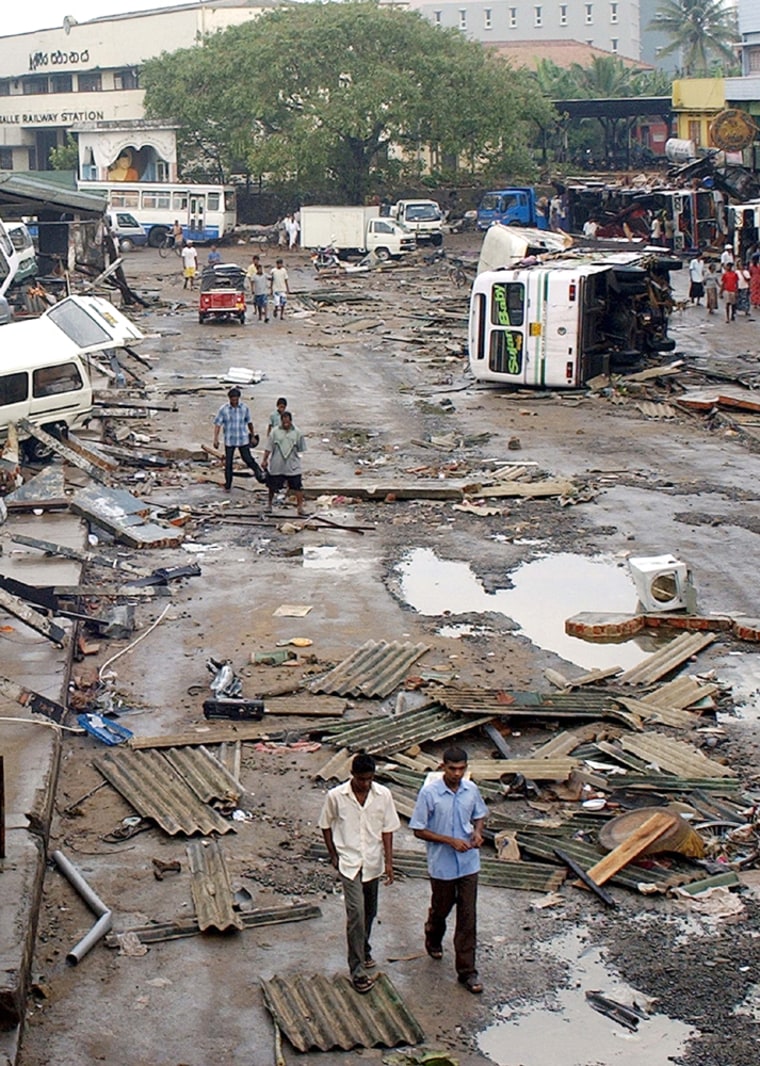The tsunami that surged across the Indian Ocean Sunday split into two mighty rivers when it reached the formidable 17th-century Dutch fortress that is the defining landmark of this southern port. The two sides of the torrent enveloped the 40-foot-high walls of the fortress and then met again behind them — at Galle's bus station.
Police said at least 200 people were killed at the terminal, the city's busiest crossroads, as buses were tossed about in the converging cascades of water. Some drowned in their bus seats; some were stabbed by shards of flying glass; some were crushed beneath sheets of metal. By the end of the day, row after row of corpses lay in the baking sun awaiting retrieval.
The devastating scene was repeated along much of the palm-fringed coastline that has become a magnet for foreign tourists in the three years since the end of Sri Lanka's brutal 20-year civil war between the majority Sinhalese and the minority Tamils. A day after the disaster, the low-lying coastal road was littered with the debris of wrecked buildings, beached boats, fallen trees, and overturned buses and cars.
As I drove along the coast Monday afternoon and saw for the first time the scale of the devastation, I better understood my own enormous good fortune in escaping one of South Asia's worst natural disasters in living memory.
When the tsunami struck, I was swimming in the ocean with my brother Geoffrey off a small island he owns, several hundred yards offshore from the village of Weligama. As the water rushed inland, we washed up on one of the colorful catamarans that locals use as fishing boats.
The force of the water was so great that many of the boats ended up hundreds of yards inland, crushing the flimsy houses that lay in their path and killing people inside. Our catamaran was wedged alongside a fishing market and some palm trees, which saved us from being swept across the road with dozens of other boats.
Woman in a sari
Returning to the scene Monday morning, I came across the house of a fisherman named Ranjith who lost seven members of his family when his boat slammed into his house. As he saw the tsunami approach, Ranjith said he had struggled desperately to secure his catamaran, but was unable to do so in time.
A little farther along the road, I came across the corpse of a distinguished-looking woman in a beautiful white sari, her handsome face framed by cascading black hair. Nobody had come to claim the body, which was covered in a sheet of plastic.
Villagers said they had recovered dozens of bodies from the houses along the seashore, most of them of women and small children who were unable to swim or lacked the strength to climb to safety. At least 200 people were killed in Weligama, and many more are still missing.
Jolting contrasts
Since there is no water or electricity there, and very little food, I brought my family Monday afternoon to Galle, a picturesque city that is normally a half-hour drive along the coast. This time the trip took two hours on the circuitous inland route we were forced to take because of downed bridges and blocked roads. We are now staying at the Dutch House, a little hotel owned by my brother, on a hill high above the flood-flattened city.
There was a jolting contrast between the scenes of utter devastation in the area along the beach, where entire streets have been reduced to piles of rubble, and the atmosphere of near-normality in the hotel, where guests were swapping disaster stories by the swimming pool while waiting for evacuation to Colombo.
Of four properties belonging to my brother along the coast, three survived the tsunami more or less intact, while the fourth was nearly destroyed. The staff at the Beach House in the resort of Tangalle alerted the sleeping British guests seconds before the giant wave struck, and they ran for safety to higher ground, leaving everything behind. They have been evacuated to a friend's house.
In the nearby town of Hambantota, hundreds of people who arrived for the weekly fish market were swept out to sea by the wave and have been reported missing.
Here in Galle, authorities estimate that as many 2,000 people were killed in the disaster, most of them in the commercial area of town and at the bus station. Armed police and troops are patrolling the streets and have imposed a nighttime curfew to prevent looting. In contrast to Weligama, where there is little organized relief effort, bulldozers have begun to remove rubble from the streets of Galle and push upturned vehicles out of the road.
Survivors of the tsunami in Galle include a touring cricket team from one of England's most elite private schools, Harrow, who were playing a Sri Lankan team in a stadium next to the bus station when the earthquake-driven wave struck. The English schoolboys clambered to safety on top of the cricket pavilion.
